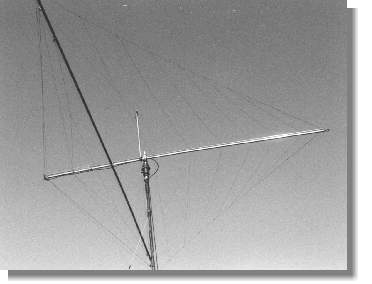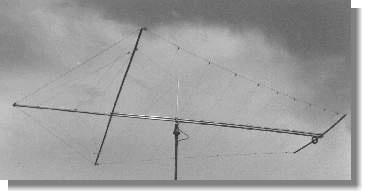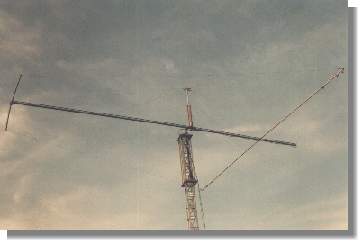The Aluminum-Titanium material allows the construction of light weight, elastic Log-Periodic antennas which - at the same time - provide low wind loads.
Log-Periodic antennas cover a wide frequency range without switching elements and are fed with just a single coax cable. Gain, bandwidth and front to back ratio remain constant over the entire frequency range - in contrary to monoband or trapped yagis.
No traps or other loading techniques will limit the useful output power to the antenna.
We use a double-boom feeding technique and a new kind of element to boom mounting. Special cross clamps provide a large contact surface for excellent RF-performance. The crossing of elements is executed by the double-boom.
The applied transmitting power is mainly limited by the power capability of the coax cable. Due to the double-boom the input impedance of the Log-Periodic antenna can be directly matched to the feed line. Additionally, the double-boom gives the antenna extreme horizontal and vertical stability. No drillings weaken the mechanical stability of the boom!
| DLP 11 | 11 Element Wire Log-Periodic | 7MHz - 30MHz | |
| DLP 15 | 15 Element Wire Log-Periodic | 7MHz - 30MHz | |
| DLP 20 | 20 Element Wire Log-Periodic | 7MHz - 30MHz | |
| DLP 22 | 22 Element Wire Log-Periodic | 3.5MHz - 30MHz |

| Very low wind load: 330N (at 120km/h) | |
| Low weight: 13kg (29lb.) DLP 11L: 9kg (20lb.) | |
| Power handling: 5kW PEP | |
| Optically very inconspicuous appearance through the use of wire elements | |
| No swinging elements at strong wind | |
| No balun necessary | |
| Double-boom (40 / 18mm) electrically fed - increased gain | |
| High number of elements due to wire stringing | |
| No corroding parts through the use of special stainless steel clamps | |
| Best low angle radiation through high number of elements | |
| Crossing-free feeding of all elements with a defined impedance | |
| Feeding with just a single coax cable for all seven bands (50 Ohm) | |
| Loss-free linear loading feeding on 10MHz, full-size rotary dipole on 7MHz | |
| Suppression of strong BC transmitters in the 7-13MHz range because 7 and 10MHz are designed as skip-frequencies (resonant bands) | |
| Boom length: 6m (19.7ft.) | |
| Longest element: 10.30m (33.8ft.) | |
| Turning radius: 5.40m (17.7ft.) | |
| Gain: 14-30MHz: 5.3dBd, 7MHz: 1dBd, 10MHz: 1dBd | |
| Front-to-back ratio: 15-20dB from 14-30MHz | |
| VSWR: typically 2:1 and better on the amateur radio bands |

| Very low wind load: 500N (at 120km/h) | |
| Low Weight: 22kg (49lb.) | |
| Optically very inconspicuous appearance through the use of wire elements | |
| No swinging elements at strong wind | |
| Power handling: kW PEP | |
| No balun necessary | |
| Double-boom (60/18mm), electrically fed = increased gain | |
| High number of elements due to wire stringing | |
| No corroding parts through the use of special stainless steel clamps | |
| Best low angle radiation through high number of elements | |
| Crossing-free feeding of all elements with a defined impedance | |
| Feeding with just a single coax cable for all seven bands (50 Ohm) | |
| Loss-free linear loading feeding on 10MHz, full-size rotary dipole on 7MHz | |
| Suppression of strong BC transmitters in the 7-13MHz range because 7 and 10MHz are designed as skip-frequencies (resonant bands) | |
| Boom length: 8m (26.2ft.) | |
| Longest element: 10.42m (34.1ft.) | |
| Turning radius: 5.78m (19ft.) | |
| Gain: 14-30MHz: 6.5dBd, 7MHz: 1dBd, 10MHz: 2dBd | |
| Front-to-back ratio: 20-25dB from 14-30MHz | |
| VSWR: typically 2:1 and better on the amateur radio bands |
| Bands: 40m, 30m, 20m, 17m, 15m, 12m, 10m | |
| Very low wind load: 800N (at 120km/h) | |
| Low Weight: 32kg (71lb.) | |
| Optically very inconspicuous appearance through the use of wire elements | |
| No swinging elements at strong wind | |
| Power handling: 5kW PEP (40m - 10m) | |
| No balun necessary | |
| Double-boom (60/18mm), electrically fed = increased gain | |
| High number of elements due to wire stringing | |
| No corroding parts through the use of special stainless steel clamps | |
| Best low angle radiation through high number of elements | |
| Crossing-free feeding of all elements with a defined impedance | |
| Loss-free linear loading feeding on 10MHz, full-size rotary dipole on 7MHz | |
| Suppression of strong BC transmitters in the 7-13MHz range because 7 and 10MHz are designed as skip-frequencies (resonant bands) | |
| Boom length: 12m (39.3ft.) | |
| Longest element: 10.42m (34.1ft.) | |
| Turning radius: 6.8m (22.3ft.) | |
| Gain: 14-30MHz: 7.5dBd, 7MHz: 1dBd, 10MHz: 2dBd | |
| Front-to-back ratio: 20-25dB from 14-30MHz | |
| VSWR: typically 2:1 and better on the amateur radio bands |

| Bands: 80m, 40m, 30m, 20m, 17m, 15m, 12m, 10m | |
| Very low wind load: 800N (at 120km/h) | |
| Low Weight: 32kg (71lb.) | |
| Optically very inconspicuous appearance through the use of wire elements | |
| No swinging elements at strong wind | |
| Power handling: 5kW PEP (40m - 10m), 3kW PEP on 80m | |
| No balun necessary | |
| Double-boom (60/18mm), electrically fed = increased gain | |
| High number of elements due to wire stringing | |
| No corroding parts through the use of special stainless steel clamps | |
| Best low angle radiation through high number of elements | |
| Crossing-free feeding of all elements with a defined impedance | |
| Feeding with two coax cables (one for 80m, one for 40m-10m) | |
| Loss-free linear loading feeding on 10MHz, full-size rotary dipole on 7MHz, rotary shortened dipole on 3.5MHz through use of TITANEXHigh-Q-coil TC100. The rotary dipole for 80 can either be tuned to 80m CW or 80m SSB. | |
| Suppression of strong BC transmitters in the 7-13MHz range because 7 and 10MHz are designed as skip-frequencies (resonant bands) | |
| Boom length: 12m (39.3ft.) | |
| Longest element: 10.42m (34.1ft.) | |
| Turning radius: 6.8m (22.3ft.) | |
| Gain: 14-30MHz: 7.5dBd, 7MHz: 1dBd, 10MHz: 2dBd, 3.5MHz: 0dBd | |
| Front-to-back ratio: 20-25dB from 14-30MHz | |
| VSWR: typically 2:1 and better on the amateur radio bands |